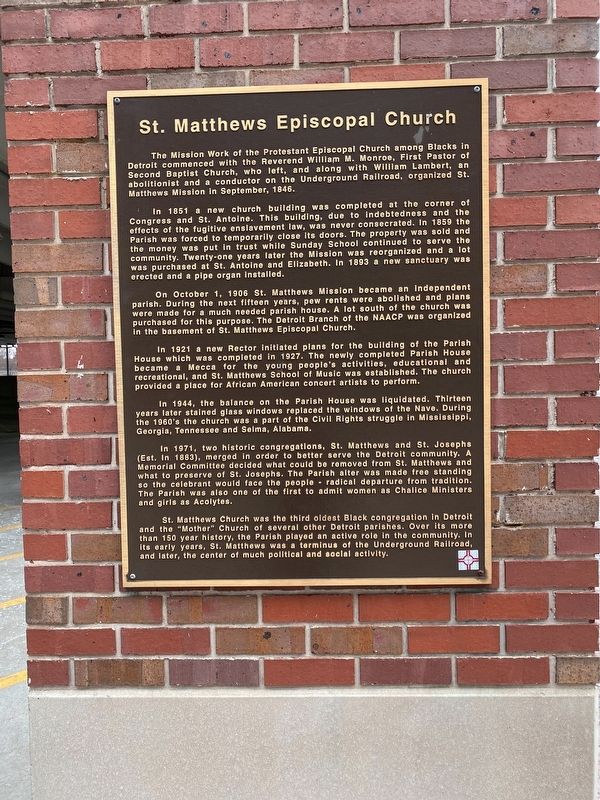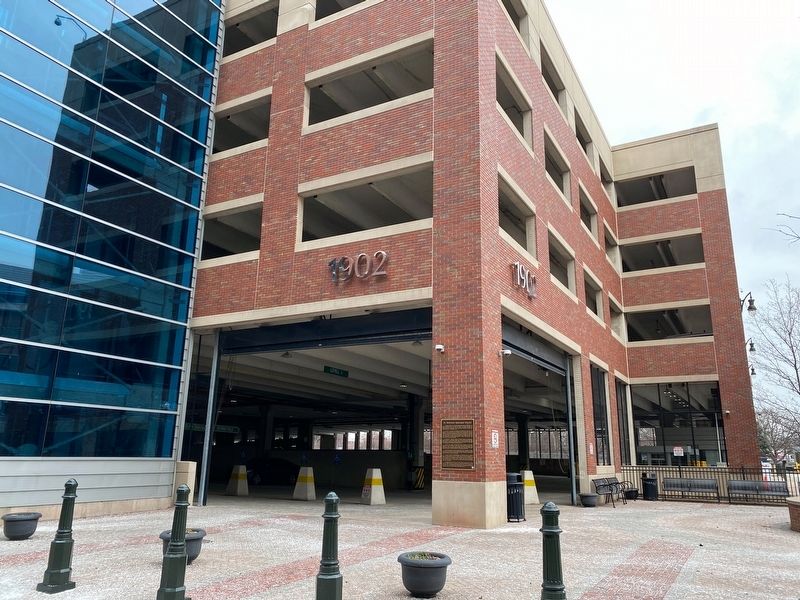Downtown Detroit in Wayne County, Michigan — The American Midwest (Great Lakes)
St. Matthew's Episcopal Church
The Mission Work of the Protestant Episcopal Church among Blacks in Detroit commenced with the Reverend William M. Monroe, First Pastor of Second Baptist Church, who left, and along with William Lambert, an abolitionist and a conductor on the Underground Railroad, organized St. Matthews Mission in September, 1846.
In 1851 a new church building was completed at the corner of Congress and St. Antoine. This building, due to indebtedness and the effects of the fugitive enslavement law, was never consecrated. In 1859 the Parish was forced to temporarily close its doors. The property was sold and the money was put in trust while Sunday School continued to serve the community. Twenty-one years later the Mission was reorganized and a lot was purchased at St. Antoine and Elizabeth. In 1893 a new sanctuary was erected and a pipe organ installed.
On October 1, 1906 St. Matthews Mission became an independent parish. During the next fifteen years, pew rents were abolished and plans were made for a much needed parish house. A lot south of the church was purchased for this purpose. The Detroit Branch of the NAACP was organized in the basement of St. Matthews Episcopal Church.
In 1921 a new Rector initiated plans for the building of the Parish House which was completed in 1927. The newly completed Parish House became a Mecca for the young people's activities, educational and recreational, and St. Matthews School of Music was established. The church provided a place for African American concert artists to perform.
In 1944, the balance on the Parish House was liquidated. Thirteen years later stained glass windows replaced the windows of the Nave. During the 1960's the church was a part of the Civil Rights struggle in Mississippi, Georgia, Tennessee and Selma, Alabama.
In 1971, two historic congregations, St. Matthews and St. Josephs (Est. In 1883), merged in order to better serve the Detroit community. A Memorial Committee decided what could be removed from St. Matthews and what to preserve of St. Josephs. The Parish alter was made free standing so the celebrant would face the people - radical departure from tradition. The Parish was also one of the first to admit women as Chalice Ministers and girls as Acolytes.
St. Matthews Church was the third oldest Black congregation in Detroit and the "Mother” Church of several other Detroit parishes. Over its more than 150 year history, the Parish played an active role in the community. In its early years, St. Matthews was a terminus of the Underground Railroad, and later, the center of much political and social activity.
Erected by Michigan Historical Commission. (Marker Number L447.)
Topics and series. This historical marker is listed in these topic lists: African Americans • Charity & Public Work • Churches & Religion. In addition, it is included in the Michigan Historical Commission series list. A significant historical month for this entry is September 1846.
Location. 42° 20.396′ N, 83° 2.617′ W. Marker is in Detroit, Michigan, in Wayne County. It is in Downtown Detroit. Marker is on St. Antoine north of Beacon Street, on the right when traveling north. The marker is mounted on the parking deck entrance on the east side of Ford Field. Touch for map. Marker is at or near this postal address: 1902 St Antoine, Detroit MI 48226, United States of America. Touch for directions.
Other nearby markers. At least 8 other markers are within walking distance of this marker. Paradise Valley (a few steps from this marker); Music Hall (approx. ¼ mile away); American Eagle (approx. ¼ mile away); Tyrus Raymond Cobb 1886-1961 (approx. ¼ mile away); On This Site Stood The Detroit College Of Law (approx. 0.3 miles away); Trinity Lutheran Church (approx. 0.3 miles away); Beatrice Buck's Paradise Valley Park (approx. 0.3 miles away); Germantown / The Harmonie Club (approx. 0.3 miles away). Touch for a list and map of all markers in Detroit.
More about this marker. Note that this marker replaced a state marker previously at this location. The previous marker's number is included on this submission although the text of the two markers is probably different.
Also see . . . Detroit’s historically black St. Matthew’s added to ‘Freedom Network’. Excerpt:
Before Harriet Tubman escaped slavery, before Abraham Lincoln was elected to Congress and before Harriet Beecher Stowe wrote Uncle Tom’s Cabin, members of St. Matthew’s Episcopal Church were helping slaves escape across the Detroit River to freedom in Canada.(Submitted on January 17, 2022, by J.T. Lambrou of New Boston, Michigan.)
Credits. This page was last revised on February 12, 2023. It was originally submitted on January 17, 2022, by J.T. Lambrou of New Boston, Michigan. This page has been viewed 304 times since then and 61 times this year. Photos: 1, 2. submitted on January 17, 2022, by J.T. Lambrou of New Boston, Michigan. • J. Makali Bruton was the editor who published this page.

